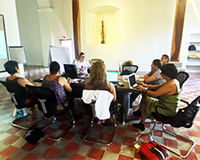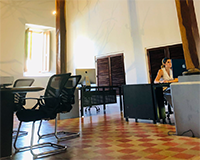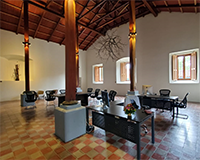FIMS News
Contact Information
FIMS Communications
Becky Blue
Email
519-661-2111x88493
FIMS & Nursing Building
Rm 2060C
FIMS PhD students and Western Libraries help launch Media Library in El Salvador
 The Mediateca at the Centro Arte para la Paz in Suchitoto preserves El Salvador's civil war memories
The Mediateca at the Centro Arte para la Paz in Suchitoto preserves El Salvador's civil war memories
November 2022
The Surviving Memory in Postwar El Salvador project is working in collaboration with Centro Arte para la Paz (CAP) in Suchitoto, El Salvador, to create a Mediateca, a digital space for the preservation of historical documents, photos, and multi-media documentation of the Salvadoran Civil War (1980-1992). In September, two Media Studies PhD students – Giada Ferrucci and Talia Méndez – traveled to El Salvador to assist the CAP team with the project launch.
With funding from the Social Sciences and Humanities Research Council of Canada (SSHRC), the Inter-American Foundation, Western Libraries, and the Faculty of Information and Media Studies (FIMS), members of the Surviving Memory team from Western – led by FIMS professor Dr. Amanda Grzyb – have been working collaboratively with CAP since 2017. CAP’s mission is to promote a culture of peace, and they use art, theatre, and music as a vehicle for healing community trauma, a legacy of the armed conflict in El Salvador.
CAP is located in the municipality of Suchitoto, El Salvador, in the former Beata Imelda College of the congregation of the Dominican Sisters, which is considered important local cultural heritage. This site has been rehabilitated to generate spaces such as gardens for peace, rooms equipped for the use of new technologies, multipurpose rooms for art workshops, and a community museum for the recovery and promotion of the historical memory.
A new page in CAP’s history:
On September 21, a new page was written in CAP's history with the inauguration of a recently-renovated chapel, which houses CAP’s new Media Library or Mediateca. The Mediateca provides access to information for visitors, students, and researchers, including historical memory records that belong to the institution, information generated by their La Memoria Viva Community Museum, online exhibitions based on the Museum’s collection, as well as third-party documents donated to CAP.
The restoration of the chapel was possible thanks to the generous support of the Inter-American Foundation, the Rotary Club Canada, the Ministry of Culture in El Salvador and the heritage resource transfer program, the Sisters of Charity from New Jersey, and Ludovico Balducci, a private donor.
For CAP's executive director, Margaret Ann O'Neill, known affectionately as Sister Peggy, the Mediateca provides an opportunity for CAP's "history must be known in order not to forget and build a present with more possibilities, with positive energies, without violence.” Likewise, she suggests that "the Media Library is an incubator, where creative ideas in digital format, achieve more accessibility and connections both at national and at international levels.”
Mediateca Image Gallery
In a process that started in October 2021, Giada Ferrucci (FIMS PhD students and lead research assistant for Surviving Memory), Tom Belton (Head of Archives and Special Collections at Western Libraries), and Amanda Oliver (Head of Archives and Special Collections at Wilfrid Laurier University Libraries), facilitated online and in-person workshop sessions and training opportunities for CAP staff and volunteers on themes such as metadata, dublin core principles, digital preservation, open access, and creative commons licensing.
In September 2022, Ferrucci and Talia Méndez (FIMS PhD student and research assistant for Surviving Memory), worked closely with the CAP Mediateca team to lead five full days of workshops to install Omeka.net as the Institutional online repository of CAP. Ferrucci and Méndez covered themes such as digital empathy for the design of heritage digital products, introduction to the new ecology of memory and the holistic view of memory as a methodology, as well as Open GLAM as a community to search for open access referents.
The Media Library is a digital storage and exchange platform of information on historical memory, facilitating academic and journalistic investigations while ensuring access to communities, said Patricia Rivera, Coordinator of the Mediateca at CAP.
With guidance from Belton and Oliver, the Surviving Memory in Post War El Salvador team began this process by analyzing the information owned by the CAP in order to create an institutional repository that would be easy to consult but also user-friendly to manage on the back-end. Ferrucci and Méndez also worked closely with the CAP team to design a pilot virtual exhibition called “Adaptation of the Mediateca.” This exhibition is a compilation of photos of the restoration process of the chapel at Centro Arte, which currently houses the Mediateca.
Q&A with Giada Ferrucci and Talia Méndez
A reference for digital information on Historical Memory:
Rivera considers the contributions of the Surviving Memory team at Western – including setting up the OMEKA software and providing training in the workshops – as essential for the launch of the Mediateca project, which aspires to become a comprehensive source of digital information on historical memory in the municipality.
While recovery of historical memory of the war in El Salvador is at a critical stage, the Mediateca also extends beyond the country’s experience in the 1980s. CAP seeks to create an open space for the transformation of the concept of historical memory by focusing on collective memories, commemorations, cultural events, cultural and tourist artistic maps.


















